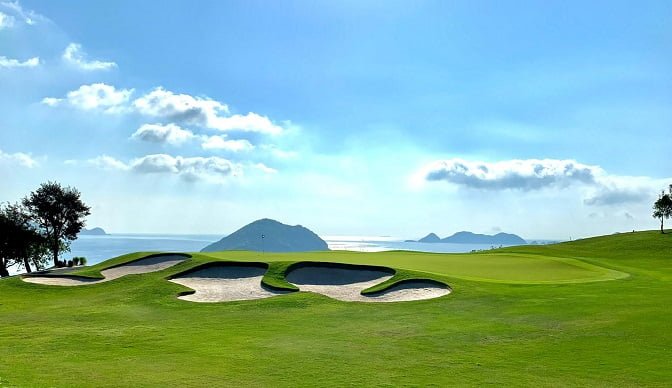All Thailand Golf Tour Tie-Up for ADT
Bangkok, Thailand: Three tournaments on the Asian Development Tour’s 2023 schedule will be jointly sanctioned w...

Hong Kong: “It’s like the Pebble Beach of Asia, except that you have the ocean on every hole and a huge marina full of enormous yachts,” says Capillary Bunkers’ CEO and inventor Martin Sternberg of the Clearwater Bay Golf Club & Country Club.
The Hong Kong venue is about to start a major bunker renovation in conjunction with the bunker liner supplier, British synthetic edging provider EcoBunker, the two companies Asian representative Centaur Asia-Pacific and Australian golf course architect Harley Kruse of KruseGolf.
Given oceanside location, and the tropical climate, which can see 20 inches of rainfall in a day during a typhoon, creating sand bunkers which are resilient is a top priority at Clearwater Bay, a Facility Member of the Asian Golf Industry Federation.
As befits a club of that status, General Manager Peter Downie was keen to ensure that the bunkers looked dramatic and attractive, too.
Initially, the plan was to build Scottish-style pot bunkers, which would make keeping sand in them easier on such an exposed and windy site. “In the 18 months prior to February 2020, our construction manager, Llewelyn Matthews, went to Clearwater Bay twice and built some pot bunkers on the practice range and also on the spare hole,” said Richard Allen, CEO at EcoBunker, a Full Business Member of the Asian Golf Industry Federation.
He added: “The proposal was to build some trial bunkers on the actual golf course, in a similar style. But when I went to site to direct the build of them, Jeffrey Eshuis of Centaur and I became concerned that the members might not like such deep bunkers.
“Peter was interested in that style, not specifically for the aesthetic, but also for their ability to hold the sand in place – which is, of course, why they are used on links courses in the first place.
“But products like Capillary Concrete keep some moisture in the sand, and that helps to keep it in place – you don’t need to have three or four foot-deep bunkers. It was at that point that I suggested to Jeffrey and Peter that the bunker style we used at Killara Golf Club might be more appropriate, and that we could assemble a team with the technological and engineering capacity to make it possible.”
Kruse Golf’s project at Killara in Sydney provided the solution. On the heavy clay soils of Killara, the architect and client team saw the combination of Capillary Concrete and EcoBunker as the solution to creating a resilient and visually striking sand faced style of bunkers.
Bunkers that echo the iconic look of classic Melbourne Sandbelt bunkering that arose from the great influence of architect Dr Alistair Mackenzie during his Melbourne design visit of 1926.
“The bunkering at Killara is proving extremely influential,” said Kruse, who grew up in Melbourne and knows Sandbelt architecture well. “Previously, it has been very difficult to build sand-faced bunkers with the vertical edge like this on clay soils and for these bunkers to withstand the extremes of weather and wear and tear of busy play.
“But now, because we have technology such as Capillary Bunkers and EcoBunker I am very confident that the bunkers will still perform very well for a very long time with very little maintenance. For a club of Clearwater Bay’s status, achieving the highest quality of outcomes of both spectacular bunkers and long-term bunker performance is really important.”
“When you see Killara, you can’t help but be impressed,” said Sternberg, whose Capillary Concrete company is an Associate Member of the Asian Golf Industry Federation.
“Using our and EcoBunker’s technology, Harley has come up with a method of building bunkers that look great and are extremely low maintenance, even though the soils are bad. And when Peter saw those bunkers, he realised they were just right for Clearwater Bay,” added Sternberg.

Clearwater Bay looked all round the world for design input, methods and materials to solve its bunker issues. “In the planning stages of the project, Clearwater Bay built a few different styles of bunkers, but all along I was saying to the club: ‘Wait till you see what Killara looks like. You’ll see that it will be perfect for your site’,” said Sternberg.
“The most interesting thing about the Clearwater Bay project is the team that has been put together to deliver the project,” said Eshuis, Managing Director at Centaur Asia-Pacific, a Full Business Member of the Asian Golf Industry Federation.
“For us, as the local distributor, it’s wonderful to have two of the great brands that we represent working together on this. We also have a great co-operation with the local contractor, Asian Sportsturf, and have provided them with specific training on the installation of our products. I’m certain the team will do a great job,” added Eshuis.
The project is ready to go as soon as the Covid-19 situation enables Kruse, and Matthews of EcoBunker, who is planned to serve as construction project manager, to get to the site.
“We can do some of the work such as fill-ins with remote monitoring of construction,” the architect says. “But for a job of this importance, it’s vital that I am on site for key milestones of the build. There are times when moving a sand line by just a few centimetres can make a huge difference, and realistically only the architect is going to notice the potential significance of such small changes.”
Bangkok, Thailand: Three tournaments on the Asian Development Tour’s 2023 schedule will be jointly sanctioned w...
Chiang Mai, Thailand: In a landmark partnership, Smartscore, an industry leader in GPS tracking solutions, will colla...
Georgia, United States: Ryder Cup host venue Marco Simone Golf & Country Club stands ready with turfgrasses from...
